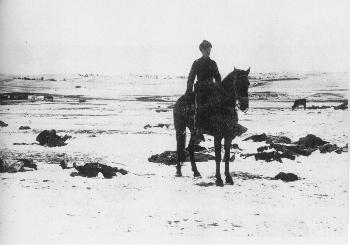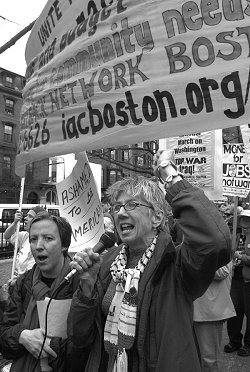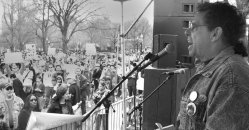Who we are
UAINE is a Native-led organization of Native people and our supporters who fight back against racism and for the
freedom of Leonard Peltier and other political prisoners. We support Indigenous struggles, not only in New England
but throughout the Americas.
We fight back on such issues as the racism of the Pilgrim mythology perpetuated in Plymouth and the U.S. government's
assault on poor people. We protest the use of racist team names and mascots in sports. We speak to classes in
schools and universities about current issues in the Native struggle. Indigenous people from North, Central or South
America who live in New England and who agree with what we are trying to do are welcome to join with us. We also
welcome the support of non-Native people from the four directions. We believe very strongly that we must support
others in struggle, particularly other communities of color, the LGBTQ community, and the disabled community.
UAINE and money
UAINE is a self-supporting organization that receives no funding from any government agency. We rely on those who
support us in our struggle for the funds needed to continue to fight that struggle. Any moneys we receive from our
participation in any program or our speaking engagements or from any other contributions go right into the UAINE
coffers. We do not have paid staffers. In other words, no one is using UAINE as a means of making a living.
UAINE and the history of National Day of Mourning
In 1970, United American Indians of New England declared US Thanksgiving Day a National Day of Mourning. This came
about as a result of the suppression of the truth. Wamsutta, an Aquinnah Wampanoag man, had been asked to speak at a
fancy Commonwealth of Massachusetts banquet celebrating the 350th anniversary of the landing of the Pilgrims. He
agreed. The organizers of the dinner, using as a pretext the need to prepare a press release, asked for a copy of the speech he planned to deliver. He agreed. Within days Wamsutta was
told by a representative of the Department of Commerce and Development that he would not be allowed to give the
speech. The reason given was due to the fact that, "...the theme of the anniversary celebration is brotherhood and
anything inflammatory would have been out of place." What they were really saying was that in this society, the
truth is out of place.
What was it about the speech that got those officials so upset? Wamsutta used as
a basis for his remarks one of their own history books - a Pilgrim's account of their first year on Indian land. The
book tells of the opening of my ancestor's graves, taking our wheat and bean supplies, and of the selling of my
ancestors as slaves for 220 shillings each. Wamsutta was going to tell the truth, but the truth was out of place.
Here is the truth:
The reason they talk about the pilgrims and not an earlier English-speaking colony, Jamestown, is that in Jamestown
the circumstances were way too ugly to hold up as an effective national myth. For example, the white settlers in
Jamestown turned to cannibalism to survive. Not a very nice story to tell the kids in school. The pilgrims did not
find an empty land any more than Columbus "discovered" anything. Every inch of this land is Indian land. The
pilgrims (who did not even call themselves pilgrims) did not come here seeking religious freedom; they already had
that in Holland. They came here as part of a commercial venture. They introduced sexism, racism, anti-lesbian and
gay bigotry, jails, and the class system to these shores. One of the very first things they did when they arrived on
Cape Cod -- before they even made it to Plymouth -- was to rob Wampanoag graves at Corn Hill and steal as much of
the Indians' winter provisions as they were able to carry. They were no better than any other group of Europeans
when it came to their treatment of the Indigenous peoples here. And no, they did not even land at that sacred shrine
down the hill called Plymouth Rock, a monument to racism and oppression which we are proud to say we buried in 1995.
The first official "Day of Thanksgiving" was proclaimed in 1637 by Governor Winthrop. He did so to celebrate the safe return of men from Massachusetts who had gone to Mystic, Connecticut to participate in the massacre of over 700 Pequot women, children, and men.
About the only true thing in the whole mythology is that these pitiful European strangers would not have survived
their first several years in "New England" were it not for the aid of Wampanoag people. What Native people got
in return for this help was genocide, theft of our lands, and never-ending repression.
But back in 1970, the organizers of the fancy state dinner told Wamsutta he could not speak that truth. They
would let him speak only if he agreed to deliver a speech that they would provide. Wamsutta refused to have
words put into his mouth. Instead of speaking at the dinner, he and many hundreds of other Native people and our
supporters from throughout the Americas gathered in Plymouth and observed the first National Day of Mourning.
United American Indians of New England have returned to Plymouth every year since to demonstrate against the
Pilgrim mythology.
On that first Day of Mourning back in 1970, Plymouth Rock was buried not once, but twice. The Mayflower was
boarded and the Union Jack was torn from the mast and replaced with the flag that had flown over liberated
Alcatraz Island. The roots of National Day of Mourning have always been firmly embedded in the soil of militant
protest.
Back to Top
Seventh Cavalry's "Glorious" History: Their first massacre was in 1868
By Mahtowin - April 10, 2003
Published in Worker's World
Since the U.S. invasion of Iraq, the big business media has made much of the spearhead role of the
Seventh Cavalry. 'Rich in glory and agony,' read the New York Times' headline about its history. The
'agony' refers to the 1876 defeat of the Seventh Cavalry and its commander, Col. George Armstrong
Custer, at Little Big Horn by combined Lakota and Cheyenne forces.
Many people know about this. But few know the rest of the "glorious" history and what preceded the battle at Little Big Horn.
Seventh Cavalry's 'glorious' history
Here, a Seventh Cavalry officer
surveys the massacre scene three days following the Dec. 29, 1890, U.S. genocidal attack on the
Lakota nation, led by Big Foot of the Hunkpapa Lakota, at Wounded Knee, Pine Ridge.
Commissioned by Congress in 1866, the Seventh Cavalry is one of the oldest continuously serving regiments in the
U.S. It was initially given the task of quelling Native uprisings and ensuring that pioneers were safe in the
Midwestern states.
On Nov. 27, 1868, Custer led the regiment in a pre-dawn raid on a peaceful Cheyenne encampment on the Washita River
in Oklahoma. It resulted in the massacre of hundreds of women, children and men. Cheyenne leader Black Kettle had
already seen many of his people massacred in 1864 at Sand Creek. He had brought the survivors to Washita.
When Black Kettle once again saw his people slaughtered, he and his wife rode out, trying to meet Custer. They
carried a white flag, hoping to stop the attack, but were shot on sight.
In the early 1870s, the Seventh Cavalry escorted surveyors, prospectors and others into the Black Hills to steal
gold and land from the Lakota people. It was a fine day, indeed, when Custer and many of his soldiers met their
death at Little Big Horn in 1876. Unfortunately, this was not the end of the Seventh Cavalry.
Wounded Knee Massacre
In late December 1890, shortly after the murder of Sitting Bull, some Minneconjou and Hunkpapa Lakota left their
reservations and headed toward the Badlands.
On Dec. 28, in the village of Wounded Knee at Pine Ridge Reservation, South Dakota, the Seventh Cavalry arrested
a group of Lakota led by Big Foot of the Hunkpapa Lakota. After disarming the Native people, the cavalry began
the Wounded Knee massacre, raining fragmentation shells into the village at a combined rate of 200 or more
rounds a minute. The 500 well-armed cavalry troops carried out the slaughter methodically.
Unarmed women, children and men were mercilessly massacred. A few ran as far as three miles only to be chased and
put to death. Frozen bodies were strewn across the snow-covered land. Many were unceremoniously dumped into a
mass grave by the cavalry.
At least 300 Lakota were massacred that day. Many said this was the "revenge" of the Seventh Cavalry for its
defeat at Little Big Horn.
Twenty Congressional Medals of Honor were awarded to these troops for this "battle."
The Seventh Cavalry was exonerated for its conduct. Secretary of War Redfield Proctor said, "[I]t was impossible
to distinguish buck from squaw. ... The bucks fired from among the squaws and children in their retreat. ... The
Indians themselves were entirely responsible for this unfortunate phase of the affair."
Army Gen. Charles Brewster Schofield, in his report regarding the conduct of the soldiers, said: "The evidence
shows that great care was taken by the officers and enlisted men to avoid unnecessary killing of Indian women
and children in the affair at Wounded Knee, and shows that the conduct of the Seventh U.S. Cavalry under very
trying circumstances was characterized by excellent discipline and in many cases by great forbearance."
This kind of lie-filled public relations disinformation sounds just like what is now coming out of the Pentagon
to cover up the U.S. military's killing of Iraqi civilians.
That was not the end of the "glorious" history of the Seventh Cavalry, however.
In 1950, the regiment slaughtered hundreds of defenseless civilians near the village of Nogun-ri, South Korea, a
massacre covered up for many years.
During the Vietnam War in the 1960s, these latter-day cowboys caused many more civilian deaths.
Perhaps this "glorious" history of slaughtering civilians in wars of imperialist conquest makes the Seventh Cavalry
ideally suited for a leading role in Iraq.
As if this history were not odious enough, subdivisions of the Seventh Cavalry have vilely appropriated the names
of Native warriors and nations, using appellations such as "Crazy Horse" and "Apache."
The Department of Defense routinely scavenges through Native heritage to give names to its tools of death and
destruction. Assault helicopters have names like the "Apache," "Iroquois," "Cayuse," "Black Hawk" and "Kiowa." There
is the "Tomahawk" cruise missile.
Naming these weapons of destruction and intimidation after Native warriors and nations is an insult.
Crazy Horse (Tashunke Witko, 1849-1877) was a great Lakota visionary and warrior who was among those who defeated
Custer at Little Big Horn. Black Hawk (Makataimeshekiakiak, 1767-1838) was a great Sauk war chief from what is
now Illinois. His eloquence and dignity, as well as his courage, were well known.
Why does the U.S. military use the names of Native people and nations? They say it is to give weapons names that
are frightening or intimidating.
In that case, says Moonanum James, a Wampanoag Vietnam-era veteran, "They should name their tools of war after
Bush, Cheney and their cohorts."
Back to Top
Moonanum's Speech, Boston Common - March 29, 2003
Good afternoon sisters and brothers:
A few short weeks ago I was honored to have opened one of the largest anti-war rally ever held in
Washington, DC. I spoke of how our very presence freed the land from those who would wage war. Today, our
presence here frees this land from those who have ordered our sons and daughters, sisters and brothers,
mothers and fathers to wage a most brutal war of racist, imperial conquest on the people of Iraq.


